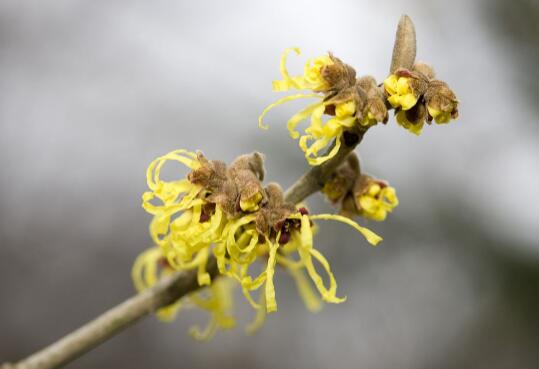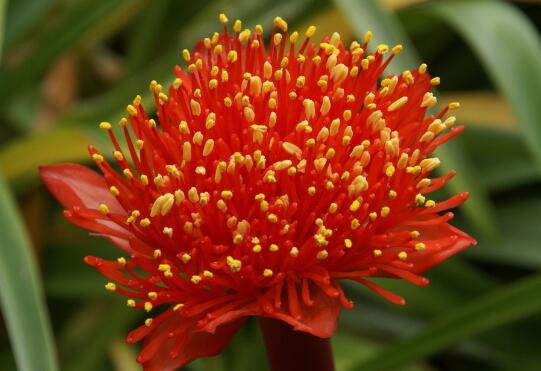Lilium lily diseases and their control methods, 5 major diseases / drugs are effective.
In the growth process of Lilium lily, if we are not careful enough, it is easy to let the disease take advantage of the disease. This kind of problem will not only affect the ornamental property of the plant, but also lead to the phenomenon of withering and dying when it is serious. so how to do the disease and control methods of Lilium lily? Next, the editor will take you to learn about it.
Lilium lily disease and its control methods
1. Penicilliosis

This disease mainly occurs in the storage period and also occurs from time to time in the growing period. when the disease is serious, the surface of the storage root will be covered with a large number of conidia of Penicillium, which is easy to infect the healthy root, and it will lead to plant rot if it is not treated in time.
Control method: when we deal with the disease of Lilium lily, we can soak the damaged root block with the 800-fold solution of 75% methyltopiramate for 10 to 15 minutes, then dry it and replant it, which can reduce the possibility of the disease.
two。 Root rot disease
Root rot is a disease caused by fungi, which, like its name, mainly harms the roots of lilies, causing them to rot gradually. The high incidence period of this disease is about March to April every year, so special attention must be paid at this time.
Control method: to prevent and cure the root rot, we can use 50% Baicaoqing wettable powder 500-800 times to irrigate the root of Lilium lilium, usually once every 3-5 days, and the disease can be basically eliminated after 1-2 times.
3. Leaf spot disease
Leaf spot is a disease caused by fungi, and its high incidence period is in spring and autumn every year, so we must pay special attention in these two seasons. Leaf spot mainly harms the leaves of Lilium lilies, there will be many prototype disease spots on the leaves, and the disease spots will gradually expand, the shape will also become irregular, it is best to lead to the gradual death of the plant.
Control method: when we control the disease of lily leaf spot, we can use 80% mancozeb 400-600 times to spray the diseased plant, which is usually sprayed once every 10-15 days, and can be cured once or twice.
4. Rhizoctonia
Rhizoctonia sclerotiorum is a disease caused by fungi. when the infection is mild, there will be many sunken light brown spots on the leaves of the lily, which will hinder the growth of the upper part of the plant if the infection is in the eyes. finally, the plant gradually withered and died.
Prevention and control methods: when we deal with this disease, we can use soil disinfectants to disinfect the suspected infected soil, and after disinfection, we must ensure that the soil is no longer infected; if the previous crops have been infected, general soil disinfectants cannot be applied, so the soil should be pre-treated with agents to control Rhizoctonia before planting.
5. Powdery mildew
Powdery mildew is just like its name, when the disease occurs, there will be many white dust-like mildew layers on the leaves, which will lead to premature senescence of lilies if they do not come out for a long time.
Prevention and control methods: when this disease occurs, we must carry out prevention and control at the initial stage, because the longer the time is, the more difficult it is to cure the disease. In treatment, we can use more than 1000 to 1500 times of antimycin to spray and control the diseased plants.
Planting techniques of Edible Lily
In our life, lilies have not only lilies that can be seen everywhere, but also edible lilies that can be seen frequently in our meals. There are many varieties and varieties of lilies, and edible lilies have the effects of moistening the lungs and relieving cough, calming the mind, relieving the mind and fighting cancer. Today we are mainly going to introduce the planting method of edible lilies, which is only for everyone's study and reference.
Planting techniques of Edible Lily
1. Land selection and preparation
Edible lilies should be planted in plots with higher topography, sunny direction, better drainage and irrigation conditions, deep soil layer and middle and upper fertility. Edible lilies can not be planted continuously, nor can they be rotated with onion and garlic crops. Leguminous or gramineous crops are better in the previous crop. Before planting, 2500 to 3000 kg of mature organic fertilizer and 25 kg of superphosphate should be applied per mu as base fertilizer, and 50% of Yannong should be turned into the soil at the same time to carry out soil disinfection. Then turn 25cm to 30cm deep. Soil preparation should fully mix the base fertilizer with the soil in order to fully improve the soil physical and chemical properties and create good conditions for root development and bulb expansion of edible lilies.
2. Selection of bulbs.
The reproduction coefficient of edible lily is low and the amount of seed used is large. The best quality for planting edible lily is Longya lily, which has large scales, shaped like dragon teeth, white and delicate, no bitterness, high price and good market. When introducing edible lily varieties, be sure to choose seeds with white color, large scales, no pockmarks and no bitterness. Generally, the economic benefit of planting middle bulb with 50-60 grams is the best. About 150 to 200 kilograms of balls are needed per mu.
3. Sowing and picking the heart at the right time.
It is suitable to sow edible lilies from late September to early October. After sowing, seedlings will not begin to emerge until the first ten days of March of the following year. The sowing specification in hilly and mountainous areas is generally 40 cm × 30 cm between rows to ensure that the population density is more than 6000 plants per mu. After sowing, it must be covered with straw or leaves to keep the land dry and there can be no stagnant water in the field.
The edible lily should be peeled when the plant has grown more than 60 leaves and the daily average temperature is less than 23 ℃. The yield of centering is higher than that of non-coring, and that of coring at the right time is higher than that of late coring. The more leaves retained for coring at the right time, the greater the yield increase. When the seedling height is 30mm, the head should be peeled off in time to promote the concentrated delivery of nutrients to the bulb.
4. Field management and fertilization
Edible lily should be covered with plastic film after sowing. The results showed that mulching edible lily for 30 days in early spring could shorten the emergence period of edible lilies for 7 days and increase the yield by 12%. In order to prevent the early withering of green leaves in the later stage of edible lilies and prolong the life of edible lily functional leaves, when the bulb expansion of edible lilies slows down in late June, 0.2% potassium dihydrogen phosphate plus 0.3% 0.5% urea should be used to apply foliar fertilizer once. Foliar fertilizer should be sprayed with 10 kg flushing water and 50 kg foliar fertilizer per mu in the first ten days of July to prevent premature senility.
5. prevention and control of diseases and insect pests and harvest
Within 1-2 days after sowing edible lily, 50-80 grams of diachlor should be sprayed per mu to prevent weeds. During the growth period of edible lilies, the main diseases and insect pests are ground tigers, aphids and virus diseases. At the initial stage of the onset of virus diseases, 1.5% Zhixianling emulsion should be sprayed 1000 times, or antiviral agent No. 1 should be sprayed 1000 times, once every 10 days for 3 times. 40% omethoate should be used to control aphids after emergence. In late April, 0.5 kg phoxim per mu was used to spread poisonous soil to kill insects underground. In the later growth stage, the larger the bulb and the higher the yield of edible lily, the greener the leaves per plant.
After the Beginning of Autumn, the stems of edible lilies have turned yellow and withered, and when the flowers have fallen off, they should be harvested in a sunny day. At this time, the harvested bulbs are fully developed, the yield is high and resistant to storage. During harvest, the bulbs should be dug up and cut off the aboveground parts, immediately transported back to indoor burial, and stored in clean river sand to prevent discoloration and dryness, affecting economic benefits.
Classification of main varieties of lily
1. Lilium lily
Curly lily also known as curly Dan, Tiangai lily, inverted lotus, tiger skin lily, pearl flower, yellow lily. It is named "Curly Dan" because of its orange-red color and reverse curl of petals.
And because of the purple-black markings on the petals, which are very similar to the patterns on the back of the tiger, it has the elegant name of tiger skin lily. It originated from China, Japan, Korea and other places, and now it is planted in many places. The height of the plant is 70cm to 100cm, sometimes as high as 1.5m, which can be called the crown of lilies. The bulb is enlarged and white in color, which can be used for food and medicine, with a slightly bitter taste. There are black and purple spots on the stem, which makes the stem dark brown. The plant has strong growth and axillary bulblets, which can be propagated by bulbs. The triploid lily is pollinated with many Asian lily species, all of which have interspecific compatibility and interspecific hybrids can be obtained.
2. Beautiful lilies
Beautiful lily, also known as deer lily, gorgeous red lily.
Luzi Lilium is native to Jiangxi Province, Zhejiang Province, Taiwan, Kyushu and southwestern coastal areas of Shikoku, Japan, with a height of 60cm. Leaves opposite, wide and sparse, hence the name big leaf lily. There are several flowers in the upper part of the stem, the petals roll outward, the stamens reveal the petals, the flowers are white and light red, and the petals are covered with rose patterns and spots, shaped like the markings on the deer, so it has the reputation of deer lilies. Those with white colors are called white deer lilies, and those with red or purple colors are called red deer lilies. Yanhong Deer Lily, a rare species from Taiwan, is called "the most beautiful lily in East Asia".
3. Shandan lily
Shandan lily is also known as Shandan flower, Shandan lily, coral lily, line lily, fine leaf lily. It gets its name because of its thin leaves and Corolla like coral. The height of the culm is 30cm to 40cm, and the leaves on the stem are 50cm and 80cm, thin and slender, as long as pine leaves. Flowers bloom in late spring and early summer, drooping, petals curling outward, bright red and shiny. Bulbs ovate or conical, scales rectangular or long ovate. Capsule moment rounded. The flowering period is from July to August and the fruit ripening period is from September to October.
4. Musk lily
Musk lily, also known as iron cannon lily, Easter lily, is the representative variety of flower lily, the flowers are pure white, cylindrical, horizontally open. It is originally from Taiwan.
The mode of reproduction of lily
1. Seed bulb reproduction. The secondary race bulb was used for reproduction. This method has the advantages of quick effect and less disease. The surface part of the aboveground stem of lilies grows bulbs 1 cm-2 cm in size, which are left behind when harvesting lilies and buried in the sand for planting in autumn.
2. Bulblet propagation. Musk lilies do not produce bulbs, other lilies can grow broad bean-sized bulbs (aerial bulbs) in summer, and each plant can produce more than 40 bulbs. With the rising temperature in summer, the bulbs will fall off, so they should be harvested before falling off and reserved for seed use, and the seeds should be sown from September to October of that year.
3. Scale propagation. This method has high reproduction coefficient and is commonly used. After the bulb is fully mature, dig it up, choose those that are fat and free from diseases and insect pests, cut off the scales from the base with a sharp knife, and then sow them in the seedbed covered with sandy loam. In order to select disease-free and healthy plants by scale propagation, the healthy plants can germinate quickly and neatly after 7 days of high temperature above 35 ℃.
The selection and purchase method of Lily
To buy fresh lilies, you should choose a large one with white color, uniform petals, thick meat and less dirt at the bottom. If the lily color is yellow and the soil is wet in the concave, it may be spermatorrhea and rotten heart. Dried lilies are dry, free of impurities, thick and crystal clear.
Edible lilies are superior to those who grow at home, taste no bitterness and have broad and thin scales. For medicinal lilies, those with wild, bitter taste and small and thick petals are better.
Due to the increasing market demand for edible lilies, the domestic planting area is too small, coupled with fewer varieties, resulting in a shortage of supply in the past two years, causing prices to soar. In this form of stimulation, many friends want to grow lilies and engage in industrial adjustment, in this case, varieties and planting techniques have become the key. Therefore, it is very important to master the planting technology of edible lilies.
- Prev

How does witch hazel reproduce? the reproduction method / sowing reproduction survival rate of witch hazel is 95%.
Witch hazel is a kind of flower plant with high ornamental value, which can be seen in many parts of our country. With more and more people raising it, people are more concerned about its reproduction. About how witch hazel propagates? What are the breeding methods of witch hazel? Next, the editor will take you to learn about it.
- Next

What to do when tennis flowers grow worms? pest control of tennis flowers / 2 insect pests 2 diseases
In the process of cultivating tennis flowers, the last thing we want to encounter is diseases and insect pests, this kind of problem is very harmful to the plant, which will not only affect the beauty of the plant type, but also lead to plant death. So what should I do if there is a bug in tennis? How to prevent and control diseases and insect pests of tennis flowers
Related
- Fuxing push coffee new agricultural production and marketing class: lack of small-scale processing plants
- Jujube rice field leisure farm deep ploughing Yilan for five years to create a space for organic food and play
- Nongyu Farm-A trial of organic papaya for brave women with advanced technology
- Four points for attention in the prevention and control of diseases and insect pests of edible fungi
- How to add nutrient solution to Edible Fungi
- Is there any good way to control edible fungus mites?
- Open Inoculation Technology of Edible Fungi
- Is there any clever way to use fertilizer for edible fungus in winter?
- What agents are used to kill the pathogens of edible fungi in the mushroom shed?
- Rapid drying of Edible Fungi

